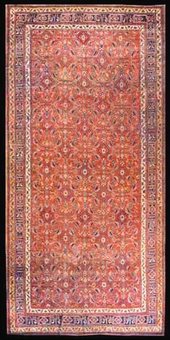Antique handmade oversize rug No. 43828 Afshar, ca. 1910 Iran 488 x 229 cm

Larger images (will open in new window)
Please click on the thumbnails below for a larger view
| main view |
 |
| Item Number: |
43828 |
| Name: |
Afshar, ca. 1910 |
| Country of Origin: |
Iran |
| Size: |
488 x 229 cm |
| Made:
|
ca. 1910 |
| Pile: |
wool |
| Design: |
floral and geometric / allover |
| Ground Color: |
old red |
| Remarks: |
This is a unique handmade / hand-knotted / traditional oriental carpet
The pile of this carpet is made of wool
Worn down to the foundation |
 add to cart
add to cart
More about the provenance Afshar, ca. 1910 | Iran
The provenance is Afshar (initially Turkish tribe which settled in Iran in the 17th century in South Iran between Shiraz and Kerman).
This is an Oriental nomadic rug. The word "nomad" comes from the Greek word "nemein". Nomads are wandering tribes, shepherds, stockbreeders, or hunters. In the minorly populated areas of Asia and North Africa they move with their herds, all their belongings and their tents to new places constantly. Many states already tried to make them settle down with various success. Mostly it is the women of the tribes which contribute to the family's income with their carpet knotting and weaving while the men breed stock or go hunting. But due to the circumstances of nomadic life the carpet production often lacks regularity and precision in form and design, which actually adds to their originality and makes them even more popular. The wool is mostly dyed with vegetable dyes.
This Afshar, ca. 1910 has a "Herati" or "Mahi" design (has its origin in Herat, ca. 16th century, short for "Mahi to Hos" meaning "fish in the pond"). A rosette is surrounded by a rhombus which is again surrounded by four bent leaves. The name "Mahi" meaning "fish" was given to this design because the leaves resemble swimming fish.

